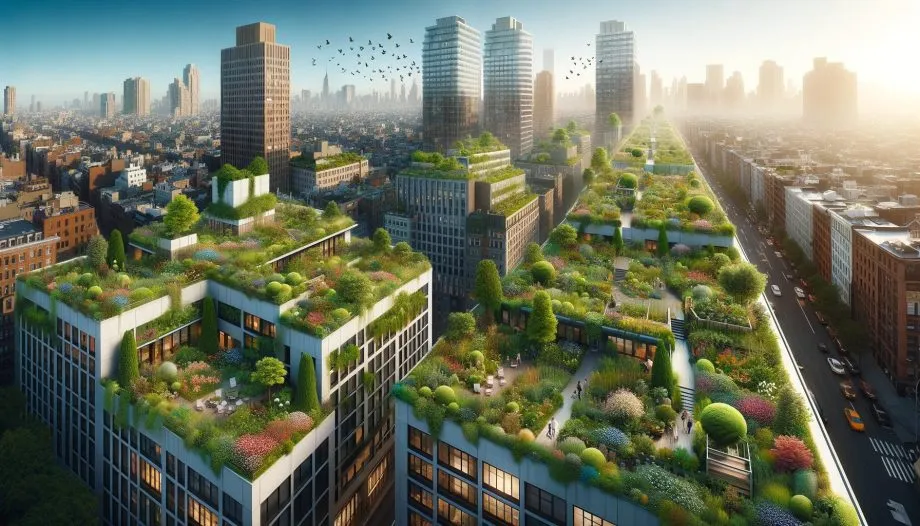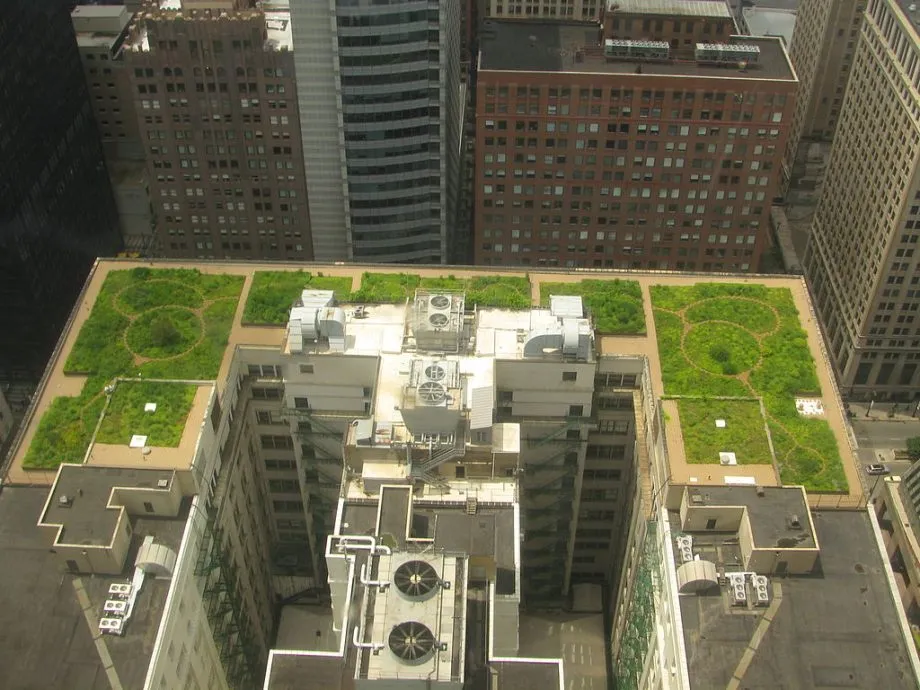This post may contain affiliate links. If you buy something from one of our links we may earn a commission. Thanks

Explore how rooftop gardens help the environment, turning urban spaces green and enhancing city life. Discover their amazing benefits in our insightful guide.
How Rooftop Gardens Help the Environment Key Takeaways:
- How rooftop gardens help the environment is multifaceted:
- They reduce the urban heat island effect
- Improve air quality by filtering pollutants
- Manage stormwater runoff
- Enhance biodiversity.
- These green spaces also offer psychological benefits, making cities more livable and sustainable.
Ever wondered how do rooftop gardens help the environment? These urban green havens are not just a treat for the eyes but a boon for our cities.
They tackle urban heat, boost air quality, and create peaceful retreats amidst concrete.
Join us as we delve into the world of rooftop gardens and uncover their remarkable impact on our urban ecosystems.
Rooftop Gardens and the Environment
Rooftop gardens are transforming urban landscapes worldwide.
These green oases, perched atop buildings, are not just a visual delight but also a step towards sustainable living.
Amidst concrete jungles, rooftop gardens offer a breath of fresh air, playing a crucial role in enhancing urban ecology. They represent innovative use of limited space in cities, providing environmental, social, and economic benefits.
What are Rooftop Gardens?
Rooftop gardens, also known as green roofs, are spaces on top of buildings where plants are grown.
They can range from simple container gardens to more complex structures with deep soil layers supporting a wide variety of vegetation.
There are mainly two types:
- Extensive Rooftop Gardens: These have shallow soil layers and are primarily designed for environmental benefits. They are usually low-maintenance and host a variety of drought-resistant plants.
- Intensive Rooftop Gardens: These are more elaborate, with deeper soil layers that can support a wider range of plants, including trees and shrubs. They often have recreational spaces and require more maintenance.
Rooftop gardens also integrate other elements like water harvesting systems and solar panels, making them a key component of eco-friendly urban design.
History and Evolution:
The concept of rooftop gardening is not new. Historical examples can be traced back to the ancient Hanging Gardens of Babylon.
In the modern era, the trend began in Germany in the 1960s and quickly spread across Europe.
Initially focused on improving building insulation and managing stormwater, the practice evolved over decades.
In the 21st century, rooftop gardens have become symbols of urban sustainability.
Cities like Toronto, Singapore, and Chicago have pioneered policies and initiatives to promote green roofs.

These gardens have evolved from mere aesthetic elements to multifunctional spaces that contribute to urban biodiversity, food production, and community engagement.
Their evolution reflects a growing recognition of the need to integrate nature into urban planning, addressing challenges like the urban heat island effect, air pollution, and loss of green spaces.
As urban populations continue to grow, rooftop gardens have become more than a trend; they are a necessity, reshaping our urban environments for the better.
The Environmental Benefits of Rooftop Gardens

Rooftop gardens are more than just urban beautification projects; they are vital tools in the fight against environmental challenges.
By turning barren rooftops into green spaces, these gardens play a significant role in improving air quality, reducing heat, and fostering biodiversity.
In cities where green space is limited, rooftop gardens are essential in creating a more sustainable and livable environment.
Combatting Climate Change:
Rooftop gardens are a frontline defense against urban climate change impacts.
They tackle the urban heat island effect, where built-up areas are significantly warmer than surrounding rural areas.
This is achieved by the plants in the gardens absorbing sunlight and providing shade. Additionally, the process of evapotranspiration from these plants cools the air naturally.
Furthermore, rooftop gardens contribute to carbon sequestration. The plants capture carbon dioxide from the atmosphere, effectively reducing the overall carbon footprint of urban areas.
This process is crucial in mitigating climate change, making rooftop gardens not just a local urban feature but a globally significant environmental tool.
Biodiversity and Ecosystem Services:
In the concrete-dominated urban landscape, rooftop gardens serve as crucial habitats for a variety of species, thus enhancing urban biodiversity.
According to UNEP and WWF, these gardens provide a sanctuary for birds, insects, and small mammals, contributing to the preservation of urban wildlife.
By introducing a variety of plant species, rooftop gardens create micro-ecosystems that support ecological networks within the city.
This increase in biodiversity is not just beneficial for wildlife; it provides substantial ecosystem services.
Pollinators like bees find habitat in these gardens, which is crucial for maintaining the health of urban flora.
The presence of diverse plant species also promotes a balanced ecosystem, which can help control pest populations naturally.
Stormwater Management:
An essential function of rooftop gardens, often highlighted by organizations like Sustainably Forward, is their ability to manage stormwater.
Urban areas, with their predominantly impermeable surfaces, face significant challenges with water runoff during heavy rains, leading to flooding and water pollution.
Rooftop gardens absorb and retain rainwater, reducing runoff and the burden on city drainage systems.
The plants and soil in these gardens act as natural filters, purifying the rainwater by removing pollutants.
This not only reduces the risk of floods but also improves the overall water quality.
The retained water can also be used for irrigating the garden itself or can be harvested for other uses, promoting sustainable water management practices in urban areas.
In summary, the environmental benefits of rooftop gardens are multi-faceted, addressing critical urban challenges like climate change, loss of biodiversity, and water management.
They represent an intersection of urban development and environmental stewardship, making them a key component in the pursuit of sustainable cities.
A table summarizing the environmental benefits of rooftop gardens:
| Benefit | Description | Impact |
|---|---|---|
| Combatting Climate Change | – Rooftop gardens absorb sunlight and provide shade, reducing the urban heat island effect.<br>- Plants in these gardens capture carbon dioxide, aiding in carbon sequestration. | – Lowers urban temperatures.<br>- Reduces overall urban carbon footprint. |
| Biodiversity and Ecosystem Services | – Provide habitats for urban wildlife including birds, insects, and small mammals.<br>- Support a variety of plant species, promoting ecological networks. | – Enhances urban wildlife diversity.<br>- Supports ecological balance and pest control. |
| Stormwater Management | – Absorb and retain rainwater, reducing runoff and strain on drainage systems.<br>- Act as natural filters, removing pollutants from rainwater. | – Decreases urban flooding risks.<br>- Improves water quality and promotes sustainable usage. |
This table encapsulates how rooftop gardens contribute to mitigating urban environmental challenges like climate change, loss of biodiversity, and ineffective stormwater management.
Each of these benefits plays a crucial role in making cities more sustainable and livable.
Rooftop Gardens in Urban Resilience
Rooftop gardens are pivotal in enhancing urban resilience, a key factor for cities facing environmental and climatic challenges.
By transforming unused roof spaces into vibrant green areas, these gardens not only beautify the cityscape but also fortify cities against environmental stresses.
They serve as strategic components in urban planning, contributing significantly to making cities more adaptable and robust against climate change impacts.
Mitigating Urban Heat Island Effect:
One of the primary roles of rooftop gardens in urban resilience is mitigating the urban heat island (UHI) effect.
This phenomenon occurs when city areas become significantly warmer than their rural surroundings, mainly due to human activities.
Rooftop gardens help regulate urban temperatures in several ways:
- Vegetation Cooling: The plants in rooftop gardens absorb sunlight, which would otherwise heat up building materials and the surrounding air.
- Evapotranspiration: This natural process, where plants release water vapor, helps cool the surrounding air.
- Insulation: The soil and plants provide insulation for buildings, reducing the need for air conditioning and thereby decreasing energy consumption.
Improving Air Quality:
Rooftop gardens significantly contribute to improving urban air quality. Plants naturally filter pollutants and particulate matter from the air, helping to purify it.
Moreover, by incorporating a variety of plant species, rooftop gardens can:
- Absorb Harmful Gases: Plants can absorb gases like carbon dioxide, nitrogen dioxide, and sulfur dioxide, common in urban areas.
- Release Oxygen: Through photosynthesis, plants release oxygen, contributing to cleaner and healthier air in urban environments.
Case Studies:

Various cities around the world have successfully implemented rooftop gardens, showcasing their benefits in urban resilience:
- Toronto, Canada: Toronto’s Green Roof Bylaw mandates green roofs on all new commercial and residential buildings, playing a significant role in the city’s green infrastructure and helping to manage stormwater, reduce the urban heat island effect, and improve air quality (source: Sustainably Forward).
- Singapore: Known for its ‘City in a Garden’ vision, Singapore has integrated numerous green roofs into its urban landscape, contributing to biodiversity, sustainability, and quality of life.
- Chicago, USA: Chicago’s City Hall boasts an extensive green roof, serving as a model for integrating nature into urban design and mitigating the urban heat island effect.
These case studies demonstrate the adaptability and effectiveness of rooftop gardens in diverse urban contexts, underlining their role in fostering more resilient and sustainable cities.
Table summarizing the key roles of rooftop gardens in mitigating the Urban Heat Island effect and improving air quality:
| Aspect | Mitigating Urban Heat Island Effect | Improving Air Quality |
|---|---|---|
| Mechanism | – Absorption of sunlight by vegetation.<br>- Evapotranspiration cooling effect from plants.<br>- Insulation provided by soil and plants. | – Filtration of pollutants and particulate matter by plants.<br>- Absorption of harmful gases by vegetation.<br>- Release of oxygen through photosynthesis. |
| Benefits | – Reduction of overall urban temperatures.<br>- Decreased energy consumption for cooling buildings.<br>- Enhanced urban comfort and livability. | – Lower levels of urban air pollutants.<br>- Improved health and well-being of residents.<br>- Contribution to cleaner and healthier urban environments. |
| Case Studies | Toronto, Canada: Implementation of Green Roof Bylaw.<br>Chicago, USA: Green roof on City Hall.<br>Singapore: City-wide integration of green roofs. | Toronto, Canada: Green roofs part of urban infrastructure.<br>Singapore: Biodiversity and air quality improvement.<br>Chicago, USA: Model for urban nature integration. |
This table encapsulates the critical roles rooftop gardens play in urban environments, focusing on temperature regulation and air quality improvement.
The case studies from Toronto, Singapore, and Chicago offer practical examples of how these benefits are realized in different urban settings.
Challenges in Implementing Rooftop Gardens
While the benefits of rooftop gardens are numerous, their implementation comes with its own set of challenges.
These issues range from structural requirements to ongoing maintenance and financial considerations.
Understanding and addressing these challenges is crucial for the successful integration and sustainability of rooftop gardens in urban landscapes.
Structural and Maintenance Challenges:
The implementation of rooftop gardens begins with a critical assessment of the building’s structural integrity. This includes:
- Weight Capacity: Ensuring the building can support the additional weight of the garden, especially in the case of intensive gardens that require deeper soil and more vegetation.
- Waterproofing and Drainage: Adequate waterproofing is essential to prevent water damage. Additionally, efficient drainage systems are needed to manage excess water, especially during heavy rainfall.
- Ongoing Maintenance: Rooftop gardens require regular maintenance, including watering, weeding, and managing the health of the plants. This necessitates a dedicated plan and resources, which might be challenging for some building owners.
Cost-Benefit Analysis:
The financial aspect of rooftop gardens is a major consideration. The initial installation costs can be substantial, including expenses for structural reinforcement, soil, plants, and installation labor.
However, the long-term benefits often offset these costs. Benefits include:
- Energy Savings: Reduced energy costs due to the insulating properties of the garden.
- Increased Property Value: Buildings with rooftop gardens may have higher market values.
- Longevity of Roof: Protection from UV rays and temperature fluctuations can extend the life of the roof.
Policy and Community Engagement:
The role of local governments and community involvement is crucial in promoting rooftop gardens. This involves:
- Policy Development: Implementing policies and incentives to encourage the installation of rooftop gardens, such as subsidies or tax breaks.
- Community Awareness: Educating the public about the benefits of rooftop gardens can foster community support.
- Partnerships: Collaboration between government, private sectors, and community organizations can facilitate the sharing of resources and knowledge, making rooftop garden projects more feasible and successful.
In summary, while there are significant challenges in implementing rooftop gardens, with proper planning, structural assessment, community engagement, and policy support, these challenges can be effectively managed.
The long-term environmental, social, and economic benefits of rooftop gardens often justify the initial investment and effort required.
Rooftop Gardens as Sustainable Urban Solutions
Rooftop gardens embody the essence of sustainability in urban environments.
By creatively utilizing underused spaces, they offer a green solution to several urban challenges.
These gardens are more than just patches of greenery; they are dynamic systems that contribute to local food production, biodiversity, and community well-being, exemplifying sustainable urban living.
Food Security and Local Produce:
Rooftop farming is an innovative approach to address food security in urban areas.
It involves cultivating edible plants and vegetables in rooftop spaces, offering several benefits:
- Local Food Production: Rooftop gardens can be used to grow a variety of food items, reducing the need for transportation and thereby decreasing carbon emissions.
- Fresh and Healthy Produce: They provide residents with access to fresh, organically grown fruits and vegetables.
- Educational Opportunities: These gardens can serve as educational platforms for urban dwellers, especially children, to learn about agriculture and sustainability.
The potential of rooftop farming is significant in dense urban areas where access to fresh produce is limited.
It can transform rooftops into productive spaces, contributing to the city’s food supply and reducing the ecological footprint associated with food transportation.
Socio-economic Benefits:
Rooftop gardens also offer a range of socio-economic benefits:
- Community Engagement and Social Cohesion: These gardens can become communal spaces where people gather, interact, and collaborate, fostering a sense of community.
- Mental Health and Well-being: The presence of green spaces in urban areas has been linked to reduced stress levels and improved mental health.
- Economic Opportunities: Rooftop gardens can create new economic opportunities, such as urban farming initiatives, green jobs, and tourism attractions.
By promoting community involvement, providing educational and economic opportunities, and enhancing mental well-being, rooftop gardens play a vital role in building sustainable, resilient, and socially cohesive urban communities.
They not only contribute to the physical environment but also the social fabric of the city, making them a comprehensive solution for sustainable urban development.
Do Rooftop Gardens Help the Environment FAQs
Rooftop gardens are fascinating and innovative, but they often raise questions about their functionality and feasibility.
In this section, we address some of the most common inquiries, providing clear answers to help readers understand the ins and outs of rooftop gardening and its implications in urban environments.
Q: How do rooftop gardens work?
A: Rooftop gardens work by utilizing specially designed systems on the roofs of buildings to support plant growth.
This involves installing waterproofing layers, drainage systems, and appropriate soil or growing mediums.
Plants are then selected based on the garden’s design – extensive or intensive – and the local climate.
These gardens can also include irrigation systems and other features like seating areas or walking paths.
Q: What are the drawbacks of rooftop gardens?
A: While rooftop gardens offer many benefits, they also have drawbacks:
- Structural Requirements: Buildings must be assessed for their ability to support the extra weight of a garden.
- Cost: The initial setup cost can be high, including expenses for structural reinforcement, materials, and installation.
- Maintenance: These gardens require regular upkeep, which can be labor-intensive and costly.
- Accessibility: Depending on the building’s design, rooftop gardens may have limited accessibility for maintenance or enjoyment.
Q: Can rooftop gardens reduce energy costs?
A: Yes, rooftop gardens can help reduce energy costs. They provide natural insulation for buildings, keeping them cooler in summer and warmer in winter.
This can lead to a significant reduction in the need for air conditioning and heating, resulting in lower energy bills.
Q: Are rooftop gardens suitable for all types of buildings?
A: Not all buildings are suitable for rooftop gardens. The feasibility depends on the structural integrity and design of the building.
Older buildings may need significant reinforcement to support the additional weight, and not all roof designs are conducive to hosting a garden.
It’s essential to consult structural engineers and architects before planning a rooftop garden.
Q: How do rooftop gardens benefit urban wildlife?
A: Rooftop gardens create habitats for various urban wildlife, including birds, bees, butterflies, and other beneficial insects.
They provide food sources and nesting areas, contributing to biodiversity in urban areas.
Q: Can I grow food in a rooftop garden?
A: Yes, many rooftop gardens are suitable for growing food.
Depending on the size and design, you can grow a range of produce, from herbs and leafy greens to vegetables and fruit-bearing plants.
However, it’s important to consider factors like sunlight, wind exposure, and water availability when selecting plants.
Q: What are the environmental benefits of rooftop gardens?
A: Rooftop gardens offer several environmental benefits, including reducing urban heat island effects, improving air quality, managing stormwater runoff, and enhancing biodiversity.
They also contribute to carbon sequestration and can help reduce the overall environmental footprint of a building.
How Rooftop Gardens Help the Environment Conclusion
Rooftop gardens, an innovative blend of nature and urban infrastructure, offer a multifaceted solution to some of the most pressing urban challenges.
From enhancing biodiversity and improving air quality to mitigating the urban heat island effect and managing stormwater, these gardens represent a sustainable approach to urban living.
They not only beautify the cityscape but also contribute to the well-being of urban residents and the environment.
Future Prospects:
The future of rooftop gardening is ripe with potential and innovation.
As urban areas continue to grow, the need for sustainable solutions becomes even more critical. We can expect to see:
- Technological Integration: Advances in technology may lead to more efficient irrigation systems, better structural designs, and smarter maintenance solutions.
- Increased Policy Support: With the growing awareness of their benefits, more cities might adopt policies and incentives to encourage the development of rooftop gardens.
- Community Involvement: There’s likely to be a rise in community-driven rooftop gardens, fostering social cohesion and providing educational opportunities.
- Diverse Applications: Beyond just green spaces, rooftop gardens could integrate with urban agriculture, contributing significantly to local food systems.
- Climate Change Adaptation: As a tool for climate resilience, rooftop gardens will be crucial in urban planning, helping cities adapt to and mitigate the effects of climate change.
Rooftop gardens stand at the intersection of ecology, technology, and community, symbolizing a progressive step towards more sustainable and resilient urban futures.
As we continue to innovate and adapt, these gardens will play a vital role in shaping the health and sustainability of our urban environments.
Visit my Amazon Influencer Page for videos and gardening products Grow Your Own Garden






